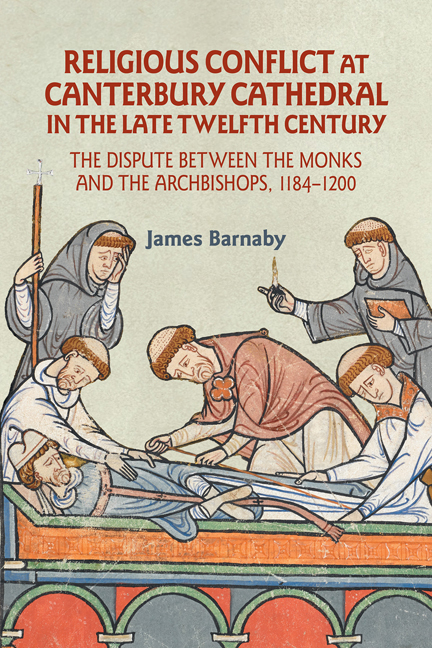 Religious Conflict at Canterbury Cathedral in the Late Twelfth Century
Religious Conflict at Canterbury Cathedral in the Late Twelfth Century On 13 January 1188, two monks of Christ Church were at the small Kentish village of Wingham, awaiting the arrival of their archbishop, Baldwin of Forde. The archiepiscopal manor at Wingham was a customary stop for prelates returning to Canterbury from the continent. Two days before, Baldwin had landed at Dover, and the monks were tasked by their subprior to welcome the archbishop home, offering him the customary procession for a returning archbishop. Baldwin, however, rejected their overtures and instead confiscated the monks’ horses, forced them to return to the convent on foot, and placed them under excommunication. That same evening, the archbishop's men tried to seize the convent. The monks closed the gate to prevent their entry and so Baldwin's men smashed their way through the precinct wall, occupying the gate and outer offices. Subprior Geoffrey (in charge of the convent as the prior was in Rome) suspended divine offices and stripped the altars. The next day, William Fitz Neal, formerly Thomas Becket's steward and now in Baldwin's service, forced the monastic servants to swear they would prevent the monks from leaving the convent. The monastery was under siege.
This was just one episode of the bitter dispute which occupied the archbishops and monks of Canterbury throughout the 1180s and 1190s. The conflict was the result of a plan by Archbishop Baldwin to build a collegiate church for secular canons, dedicated to Thomas Becket. The aim was to provide the archbishop with a source of patronage for the clerks of his administration, thereby decoupling the archbishops from their dependence upon a monastic cathedral chapter, in effect undoing 600 years of the work of Augustine, Dunstan, and Lanfranc. The initial site selected for the foundation lay at Hackington, just outside Canterbury, with Lambeth quickly emerging as an alternative. The monks of Christ Church believed that the archbishop's plan would not only weaken their status (or remove them) as the cathedral chapter but, in short order, threatened to deprive them of the relics of their recently acquired but most beloved saint, Thomas Becket. To stop the plan, the monks sought the pope's aid by appealing to Rome.
Wrapped up in the conflict about the church were arguments over other aspects of monastic life at Canterbury, which were also issues at other monastic cathedrals. The first of these was the role of the bishop.
To save this book to your Kindle, first ensure [email protected] is added to your Approved Personal Document E-mail List under your Personal Document Settings on the Manage Your Content and Devices page of your Amazon account. Then enter the ‘name’ part of your Kindle email address below. Find out more about saving to your Kindle.
Note you can select to save to either the @free.kindle.com or @kindle.com variations. ‘@free.kindle.com’ emails are free but can only be saved to your device when it is connected to wi-fi. ‘@kindle.com’ emails can be delivered even when you are not connected to wi-fi, but note that service fees apply.
Find out more about the Kindle Personal Document Service.
To save content items to your account, please confirm that you agree to abide by our usage policies. If this is the first time you use this feature, you will be asked to authorise Cambridge Core to connect with your account. Find out more about saving content to Dropbox.
To save content items to your account, please confirm that you agree to abide by our usage policies. If this is the first time you use this feature, you will be asked to authorise Cambridge Core to connect with your account. Find out more about saving content to Google Drive.